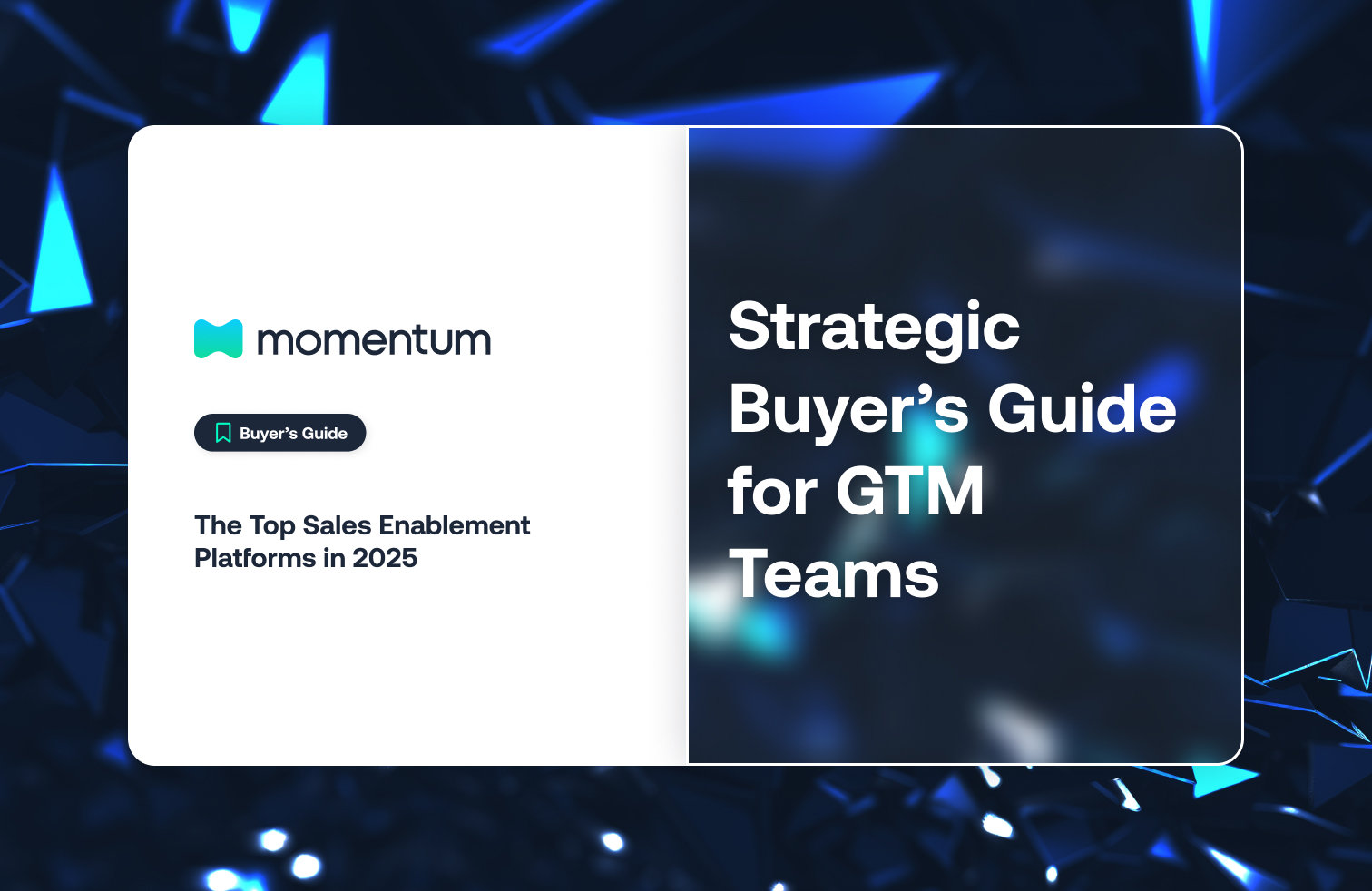The Top Sales Enablement Platforms in 2025: Strategic Buyer’s Guide for GTM Teams
Why Sales Enablement Platforms Now Drive GTM Outcomes
In 2025, sales enablement is a mission-critical lever for growth. As modern B2B buying cycles stretch longer, involve more stakeholders, and favor digital-first engagement, the enablement function has undergone a full-scale transformation. Today’s sales enablement platforms empower revenue teams across the go-to-market (GTM) motion (not just salespeople) to deliver high-impact, personalized experiences at every stage of the buyer’s journey.
This shift has turned the category into something more dynamic: revenue enablement. Instead of just supporting sales reps, top platforms now enable synchronized collaboration between sales, marketing, and customer success teams.
These systems surface real-time insights, automate content delivery, enforce playbook consistency, and deliver AI-powered coaching at scale. If your sales enablement software still feels like a glorified content repository, you're missing the point and losing deals.
Meanwhile, AI has permanently reshaped what best-in-class sales enablement tools deliver. From conversation intelligence and automated call summaries to predictive content recommendations and Slack-triggered workflows, AI is the foundation. In this guide, we break down the top platforms leading the sales enablement category in 2025, what to look for, and how to choose the right fit for your team.
What Is a Sales Enablement Platform in 2025?
At its core, a modern sales enablement platform equips revenue teams with the tools, training, content, and automation they need to deliver consistent, high-impact customer interactions. But the category has evolved. In 2025, enablement software is expected to:
[blue-section]
- Unify sales content management, onboarding, coaching, and analytics
- Automate repetitive sales tasks and workflows using AI
- Provide real-time, role-based insights across the sales cycle
- Deliver just-in-time learning and content recommendations
- Seamlessly integrate with your CRM, email, and collaboration stack
[/blue-section]
Most importantly, the best sales enablement tools now act as AI-powered copilots, anticipating what sales reps, managers, and even customer success teams need, and delivering it at exactly the right time. The focus has shifted from basic enablement to end-to-end revenue orchestration.
Modern GTM Challenges & Why Enablement Often Falls Short
Even with mature CRMs, sales playbooks, and content libraries in place, many GTM teams still struggle to execute. Here’s what’s broken:
[blue-section]
- Fragmented content systems: Marketing creates content, but sales reps waste time hunting for it, or worse, never use it.
- Inconsistent onboarding: New sales reps face bloated training portals and slow ramp times, hurting team performance.
- Lack of real-time coaching: Managers can’t keep up with call reviews, follow-ups, and performance metrics at scale.
- Manual CRM updates: Reps spend hours updating fields, logging notes, and writing follow-ups, which slows down selling.
- Disconnected tools: Sales enablement, CRM, email, and Slack often operate in silos, creating friction across the buyer journey.
[/blue-section]
The result? Wasted hours, missed follow-ups, stale messaging, and lost opportunities. Sales enablement platforms in 2025 must do more than manage assets. They must integrate, automate, and optimize the entire revenue engine.
What to Look for in a Sales Enablement Platform: Key Evaluation Criteria
Here are seven feature pillars that define the best sales enablement platforms in 2025. These are your must-haves.
1. AI-Powered Content Management & Recommendations
What it should do: Auto-surface the right content (case studies, sales decks, battlecards) based on deal stage, buyer persona, or CRM triggers.
----------
Why it matters: Sales reps need to deliver the right content at the right time, not dig through folders. AI recommendations ensure content is contextually relevant and always up to date.
----------
Avoid: Static repositories without usage tracking or dynamic delivery.
2. Sales Training & Coaching Automation
What it should do: Deliver structured onboarding, interactive role-playing, AI-based coaching, and continuous skills reinforcement.
----------
Why it matters: Sales teams change fast. Platforms must help ramp new hires, improve rep performance, and deliver personalized coaching at scale.
----------
Avoid: One-size-fits-all LMS tools with zero real-time feedback.
3. Real-Time Sales Insights & Alerts
What it should do: Track buyer engagement, flag risk signals, and trigger workflows via Slack, email, or CRM.
----------
Why it matters: Sales leaders need visibility into sales activities, stalled deals, and rep performance without chasing data. Reps need cues to act faster.
----------
Avoid: Dashboards that require manual updates or after-the-fact analysis.
4. Integrated Digital Sales Rooms (DSRs)
What it should do: Centralize content sharing, messaging, and collaboration with prospects in one branded environment.
----------
Why it matters: Buyer engagement improves when everything is accessible in one place, no more tracking files via email threads.
----------
Avoid: Platforms that only offer external links or make version control a nightmare.
5. CRM Integration and Workflow Automation
What it should do: Auto-sync content usage, rep activity, and follow-ups into your CRM (Salesforce, HubSpot, etc.) and streamline updates.
----------
Why it matters: The platform should work within your existing customer relationship management system, eliminating data silos and boosting data hygiene.
----------
Avoid: Tools that require reps to duplicate work or rely on third-party syncs.
6. Predictive Analytics and Reporting
What it should do: Track content effectiveness, coaching impact, pipeline trends, and team engagement at a glance.
----------
Why it matters: GTM leaders need actionable insights to improve enablement programs, support reps, and forecast revenue more accurately.
----------
Avoid: Static reports without buyer engagement data or contextual relevance.
7. Scalability Across Teams & Roles
What it should do: Support sales reps, managers, marketing teams, and customer success with tailored dashboards and AI agents.
----------
Why it matters: Enablement success depends on cross-functional adoption. Look for platforms that empower all roles, not just sellers.
----------
Avoid: Tools designed only for sales or marketing, not the entire GTM motion.
Top Sales Enablement Platforms in 2025: Vendor-by-Vendor Breakdown
Each of the platforms below offers a distinct approach to sales enablement, content management, and GTM optimization. Here's how they stack up.
1. Momentum

::autoboxgrid2
[LEFT]
Best for:: GTM teams seeking an AI-native platform to orchestrate data, alerts, and workflows across the sales stack.
Pricing:: Custom; ROI often realized in under 6 months
Key Features:: Real-time alerts for churn risk, buyer silence, and competitor mentions. Auto-summary of calls and MEDDPIC updates into Salesforce. Slack-based deal rooms, briefings, and AI-triggered workflows. “Spotless Follow-ups” and Ask Momentum AI Q&A assistant.
[RIGHT]
Strengths:: Eliminates manual data entry with CRM auto-updates. Deeply integrated with Slack, Salesforce, and data warehouses. Role-based AI agents (for CROs, CSMs, Sales, Enablement, Product).
Considerations:: Functions as a strategic orchestration layer. Best fit for mid-to-enterprise orgs managing complex tech stacks.
::endautoboxgrid2
2. Highspot
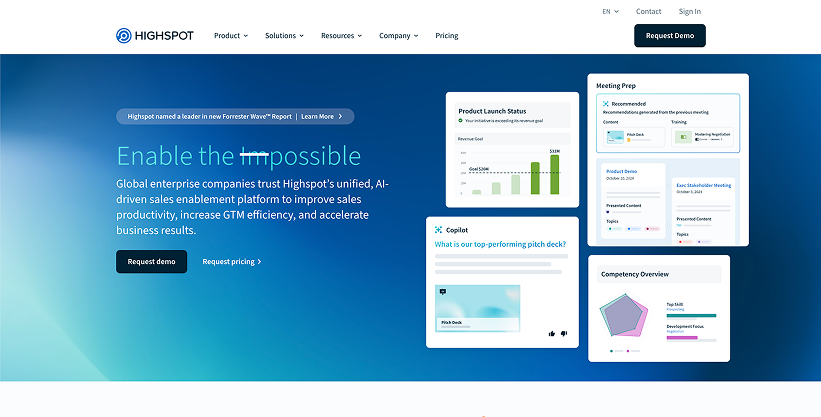
::autoboxgrid2
[LEFT]
Best for:: Teams seeking powerful AI-driven content management, training, and sales engagement tools.
Pricing:: Custom pricing; perceived as $$$$$ based on G2 reviews. Avg. implementation time: 2 months.
Key Features:: AI-powered content recommendations and semantic search. Engagement Genomics™ for linking buyer engagement to CRM. Copilot for meeting summaries, email drafts, and conversation intelligence. Digital sales rooms with real-time buyer engagement insights.
[RIGHT]
Strengths:: Unified experience: content, coaching, and sales playbooks in one platform. Over 50 integrations (Salesforce, Outlook, Zoom). Personalization at scale for both reps and marketing teams.
Considerations:: Advanced features may be underutilized by smaller teams. Search functionality can be limited without Aura AI. Higher learning curve for admins managing complex content analytics.
::endautoboxgrid2
3. Mindtickle
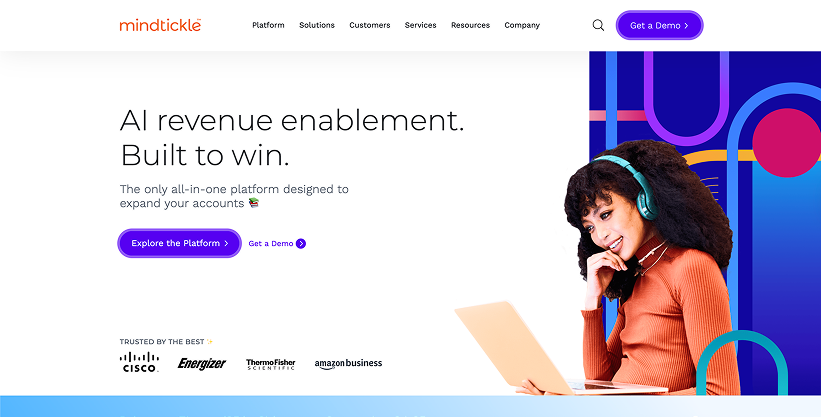
::autoboxgrid2
[LEFT]
Best for:: Enterprise teams prioritizing sales training, enablement programs, and AI-assisted coaching.
Pricing:: Custom pricing; perceived as $$$$; ROI within 16 months on average.
Key Features:: AI-powered role-playing, training paths, and program development. Rich analytics tied to revenue growth and rep effectiveness. Copilot for automated content surfacing and contextual emails. Integrated digital sales rooms and CRM sync.
[RIGHT]
Strengths:: Scientifically grounded training with high sales performance ROI. Personalized coaching powered by AI-driven conversation analysis. Scalable platform built for large, global sales teams.
Considerations:: Can be feature-heavy and overwhelming for new users. Setup of integrations may require technical assistance. Frequent updates may require user re-education.
::endautoboxgrid2
4. Showpad
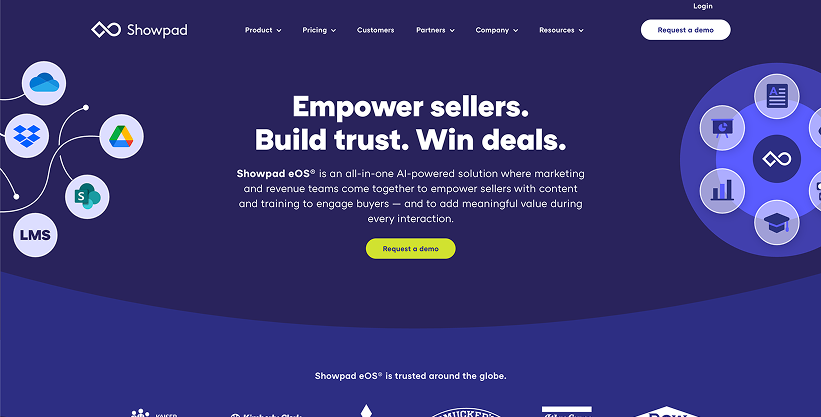
::autoboxgrid2
[LEFT]
Best for:: Organizations focused on content management, coaching, and immersive buyer engagement.
Pricing:: Tiered (Content, Coach), perceived as $$$$; ROI seen in ~21 months.
Key Features:: AI-curated home screen with dynamic content surfacing. Interactive digital sales rooms (Shared Spaces). Sales coaching with real-time feedback (Pitch IQ). AI-generated insights for content and pitch optimization.
[RIGHT]
Strengths:: Strong UI/UX that drives user adoption across sales reps. Excellent collaboration between sales and marketing teams. Robust CRM integrations (Salesforce, Outlook).
Considerations:: Not all integrations (like HubSpot) are fully mature. Reporting dashboards could be more customizable. Search accuracy can vary depending on content quality.
::endautoboxgrid2
5. Salesforce Sales Cloud

::autoboxgrid2
[LEFT]
Best for:: Teams already operating within the Salesforce ecosystem looking for native enablement capabilities.
Pricing:: Starter ($25), Professional ($80), Enterprise ($165)/user/month
Key Features:: AI-powered Einstein Conversation Insights. Real-time coaching via Agenorce Sales Coach. Centralized dashboards and CRM-embedded workflows. Automated follow-ups and keyword tracking.
[RIGHT]
Strengths:: Unified data source across sales, service, and marketing. Extensive automation across the entire sales cycle. Scales well with complex, enterprise customer relationships. Considerations:: Implementation can be complex. Steeper learning curve for enablement leaders.
Considerations:: Complex UI and steep learning curve. Premium features require additional licensing. Can be cost-prohibitive for smaller GTM orgs.
::endautoboxgrid2
6. Allego

::autoboxgrid2
[LEFT]
Best for:: GTM teams needing a mobile-friendly, rep-centric platform for learning, coaching, and buyer collaboration.
Pricing:: No public pricing; enterprise focus implies higher-end $$$$+
Key Features:: Virtual coaches, AI-based feedback, and hot-seat drills. Unified content hub with personalization capabilities. Scored live calls and sales activity tracking. Interactive video-based learning for skill mastery.
[RIGHT]
Strengths:: Consolidates sales training, coaching, and content creation. Delivers real-time coaching that scales across distributed teams. Ideal for hybrid or remote sales enablement strategies.
Considerations:: AI agent may need prompt refinement to deliver best results. Customer support can be delayed (up to 48 hours). Data upload process for historical records is manual.
::endautoboxgrid2
7. Spekit
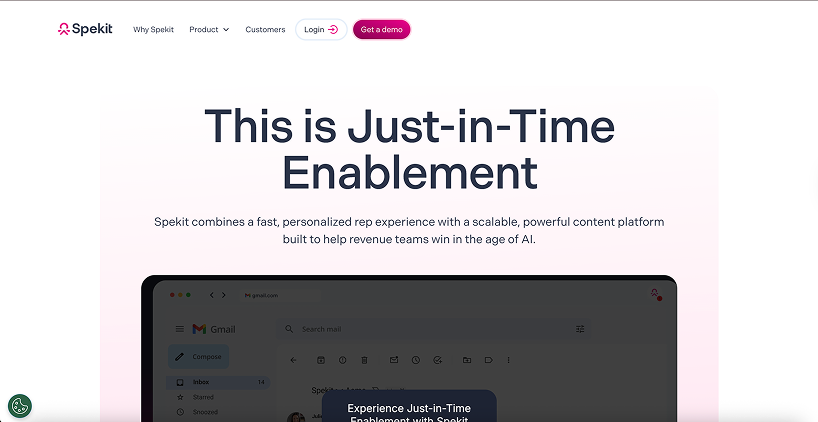
::autoboxgrid2
[LEFT]
Best for:: GTM teams that want AI-first, just-in-time enablement and content management that unifies content, guidance, and buyer collaboration without the overhead of a legacy CMS/LMS.
Pricing:: Custom pricing perceived as $$. Return on investment in less than 3 months.
[RIGHT]
Strengths::
- AI Sidekick: Instant, contextual answers and content recommendations surface where your reps are already selling.
- Intelligent CMS: Auto-tagging, dedupe, versioning, and “auto-update at scale.”
- Spotlights & knowledge checks: Nudge, verify, and reinforce updates in the flow of work.
- Deal Rooms (digital sales rooms): Share curated content, timelines, and updates from a single, always-current link.
- Revenue insights: Map engagement to opportunities and influenced revenue in CRM.
- Works anywhere, automatically: Automatically works in any application via the Chrome Extension. Deeper integrations to Salesforce, Outlook, Slack, and more available.
Considerations:: Best outcomes come from syncing your disparate content into the intelligent CMS, ship change alerts with Spotlights, reinforce with short knowledge checks, coach teams to “ask Sidekick” (not hunt folders), auto-govern content (versioning/expiry), and wire attribution to Salesforce so every engagement, content interaction, and follow-up is revenue-tracked.
::endautoboxgrid2
Comparison Table: Sales Coaching Platforms That Analyze Sales Interactions
::autotable
::columns=8
Platform
Best For
AI Coaching
Content Management
Real-Time Alerts
DSRs
CRM Integration
Pricing
Highspot
Sales reps & marketers
✅
✅
✅
✅
✅
$$$$$
Mindtickle
Sales training & onboarding
✅
✅
✅
✅
✅
$$$$
Showpad
Buyer engagement & collaboration
✅
✅
✅
✅
✅
$$$$
Salesforce Sales Cloud
CRM-native workflows
✅
✅
✅
❌
✅
$$$$$
Allego
Remote & hybrid teams
✅
✅
✅
✅
✅
$$$$+
Gong
Pipeline forecasting & coaching
✅
✅ (via call data)
✅
❌
✅
$$$$$
Momentum
Full GTM orchestration
✅
✅ (AI-native)
✅
✅
✅
Custom
::endautotable
::footerrow ✅ Full Native Support ;; ⚠️ Partial or basic functionality ;; ❌ Not Supported
All platforms support AI-powered workflows, content surfacing, and actionable insights, but differ significantly in how they address automation, rep coaching, data pipelines, and sales engagement platform fit.
Why Momentum Is Your GTM Orchestration Advantage
Most sales enablement platforms focus on rep enablement. Some help with content. Others track pipeline. But very few deliver real-time execution power across your entire GTM motion. That’s where Momentum stands apart.
Momentum is not another dashboard for your sales leaders to manage. Instead, Momentum operates as a real-time orchestration layer, turning unstructured customer interactions — calls, emails, messages — into structured, usable data, and then triggering workflows across your stack based on that data.
It’s a purpose-built, AI-native platform for:
[blue-section]
- Structuring CRM fields like MEDDPIC automatically after sales calls
- Delivering AI-powered summaries and follow-ups straight into Slack
- Identifying churn risk, competitor mentions, and buyer engagement signals
- Accelerating decision-making with CRO-level executive briefs
[/blue-section]
Momentum improves team performance, cuts admin time, and creates a scalable system of execution, across sales, marketing, customer success, and RevOps.
How Momentum Powers the Entire Revenue Team
Momentum’s AI-powered sales enablement software is designed with cross-functional value in mind. Here’s how it supports key GTM stakeholders:
[number-block number="1"]
Sales Reps (BDRs / AEs)
- Receive real-time deal updates and pre-call briefs in Slack
- Skip manual CRM entry, Momentum updates Salesforce for them
- Get instant answers with “Ask Momentum” for fast context switching
- Auto-send spotless follow-up emails using conversation summaries
Impact: Less admin, more time to close deals, and increased sales productivity
[/number-block]
[number-block number="2"]
Sales Managers & Enablement Leaders
- Use Momentum’s Coaching Agent to flag issues and opportunities
- Access structured call summaries and best-practice playlists
- Deliver real-time coaching based on actual buyer interactions
- See where reps need support without reviewing every call
Impact: Consistent sales coaching, faster onboarding, and data-driven feedback
[/number-block]
[number-block number="3"]
Revenue Operations
- Improve CRM data hygiene through automation, not rep reminders
- Build Slack-triggered workflows based on pipeline signals
- Eliminate data silos by integrating Slack, Salesforce, Snowflake, and more
- Manage custom workflows to match your GTM sales process
Impact: Better forecasting, stronger ops execution, and fewer blind spots
[/number-block]
[number-block number="3"]
Customer Success Managers
- Get complete call histories and sentiment scores during handoffs
- Use Account Rooms in Slack to collaborate cross-functionally
- Respond to churn signals in real time with automated alerts
Impact: Higher retention, improved customer experiences, and proactive support
[/number-block]
[number-block number="4"]
Marketing & Product Teams
- Access anonymized buyer objections, feature requests, and pain points
- Learn how messaging lands in real conversations
- Receive AI-generated briefs and content recommendations for future assets
Impact: Build more relevant content, refine messaging, and strengthen alignment
[/number-block]
Momentum vs. Traditional Sales Enablement Tools
::autotable
::columns=3
Category
Momentum
Traditional Platforms
Data Capture
Real-time from calls, emails, and Slack
Manual CRM notes or rep entry
Alerts & Signals
Slack-triggered, AI-curated
Limited or post-event dashboards
Workflow Automation
Deep CRM/Slack integration
Siloed tools and fragmented handoffs
Role-Based AI Agents
CRO, Sales, CS, Enablement, Product
Mostly rep-focused
Sales Process Orchestration
Full pipeline coverage
Spot-solution functionality
Real-Time Coaching
Based on live interactions
Based on reviewed calls or quiz modules
Data Democratization
Slack, Salesforce, Snowflake
Often locked inside platform-only portals
::endautotable
Momentum acts as the connective tissue between your sales activities, enablement programs, and revenue insights. It’s the difference between measuring execution and actually orchestrating it across the stack.
Choose a Platform That Orchestrates Outcomes, Not Just Insights
Whether you’re optimizing enablement programs, increasing seller readiness, or improving forecasting accuracy, the stakes are high in 2025. The right platform does more than just manage content or track playbook compliance: it enables action, aligns teams, and drives revenue growth.
If you’re choosing a sales enablement platform, consider your needs:
[blue-section]
- Need to scale onboarding and performance? → Consider Mindtickle or Allego
- Looking to drive content-led buyer engagement? → Highspot or Showpad are strong
- Want to deepen call coaching and conversation intelligence? → Gong leads the pack
- Already on Salesforce and want native AI? → Salesforce Sales Cloud or Allego
- Need to unify everything with AI-driven, real-time orchestration? → Momentum delivers
[/blue-section]
Ready to See Momentum in Action?
Thousands of GTM teams (from RevOps leaders to frontline sellers) use Momentum to streamline enablement, accelerate deal cycles, and eliminate sales execution blind spots. Here’s what you can expect:
[blue-section]
- AI-powered call summaries, MEDDPIC automation, and CRM updates
- Slack-based workflows for deal alerts, coaching moments, and renewal escalations
- Real-time signals on churn risk, competitor mentions, and deal blockers
- Deep integration with Salesforce, Slack, HubSpot (coming soon), Zoom, Snowflake, and more
[/blue-section]
No more silos. No more missed follow-ups. No more sales content lost in the void.
Momentum gives you the data, visibility, and automation to deliver personalized, scalable sales enablement at every touchpoint and drive outcomes that matter.
Book a Demo Today
If you’re serious about sales performance, team alignment, and AI-powered enablement, Momentum is the platform to make it happen.
[white-section]
Book a demo and see how Momentum fits into your current tech stack (Salesforce, Slack, HubSpot, and beyond).
Let AI handle the admin. Let your sales team do what they do best: close deals.
[/white-section]




.svg)
